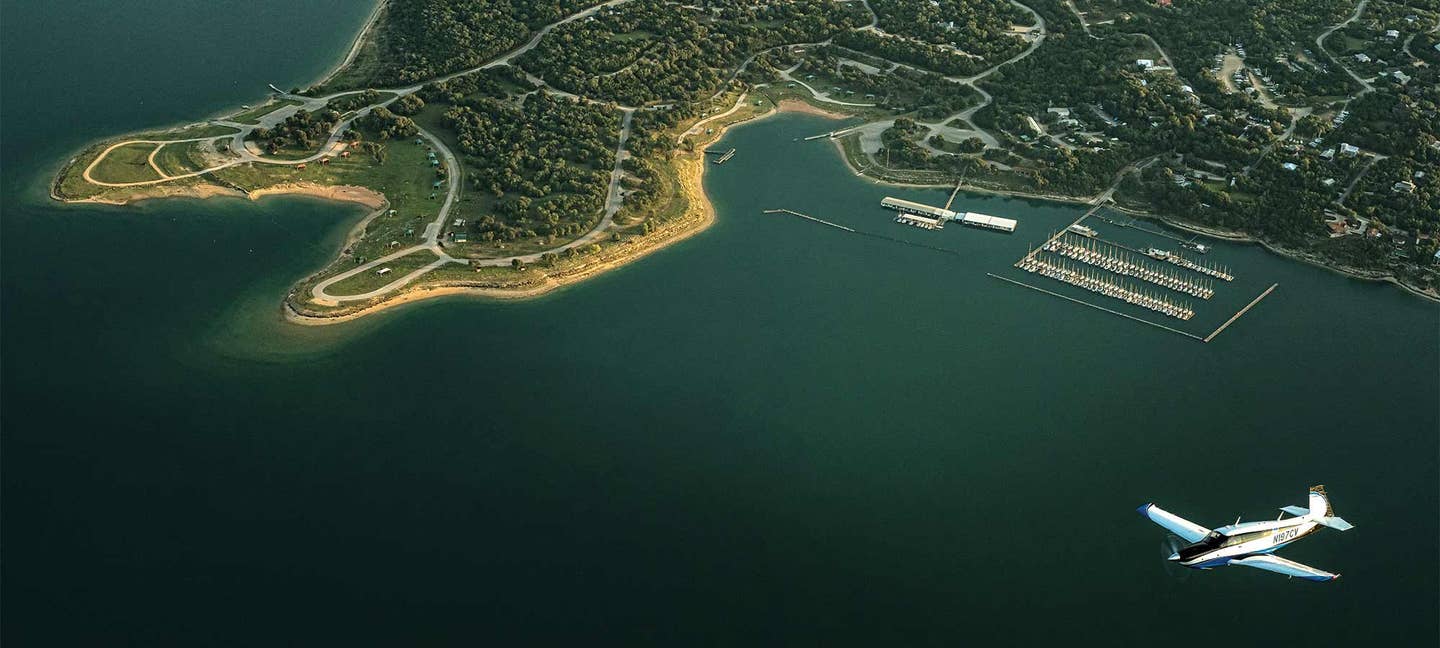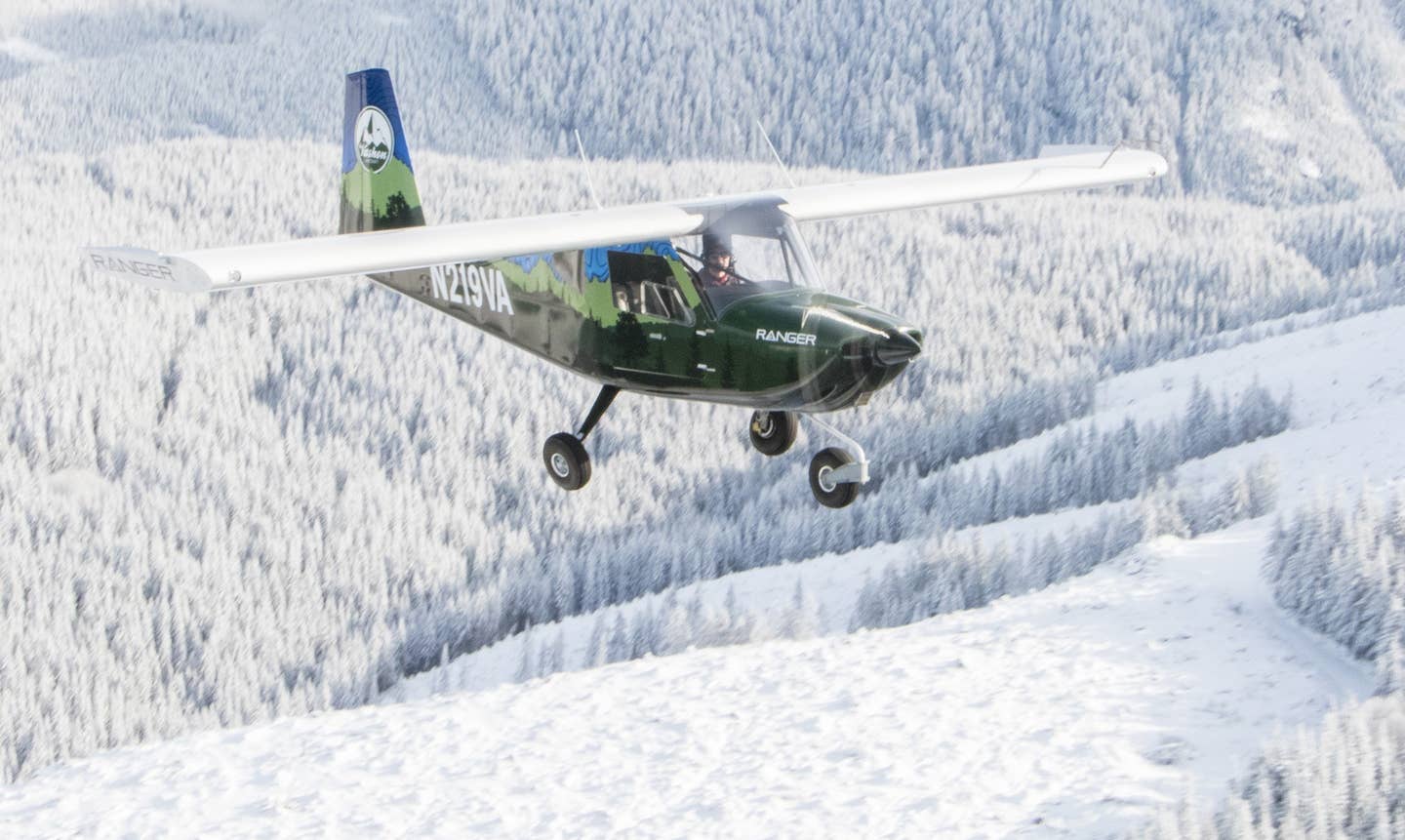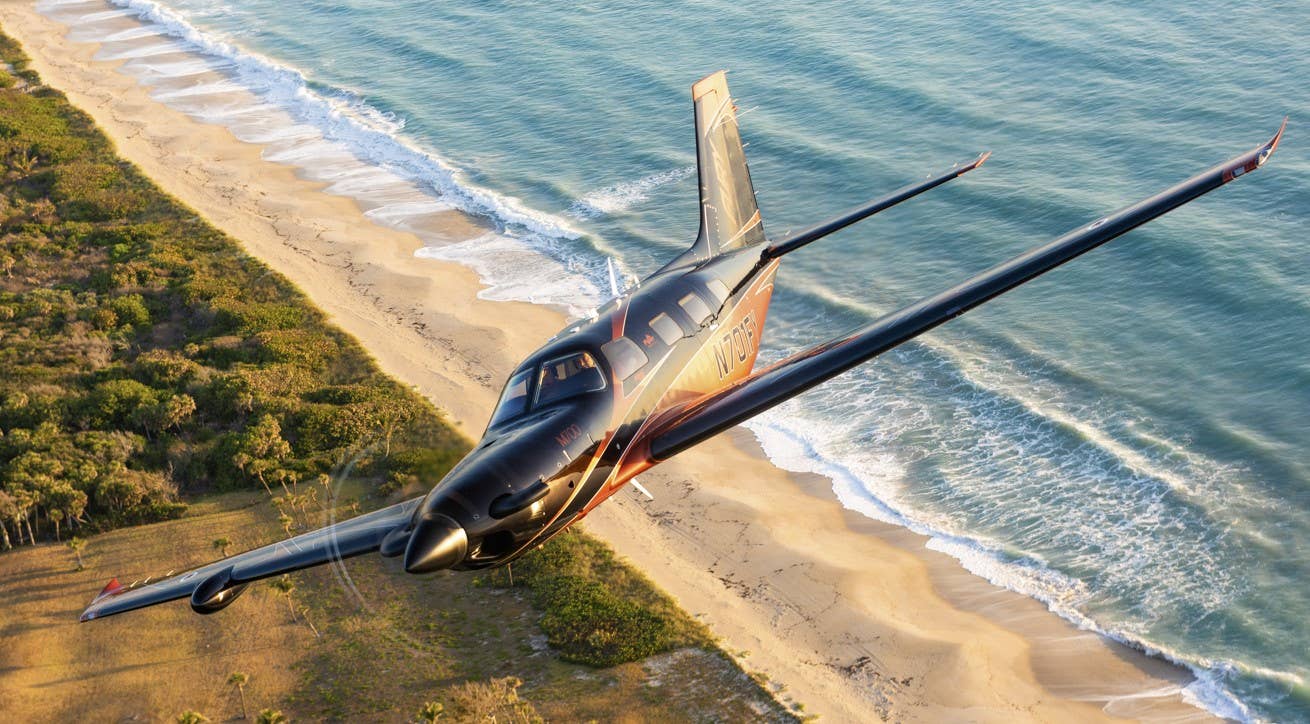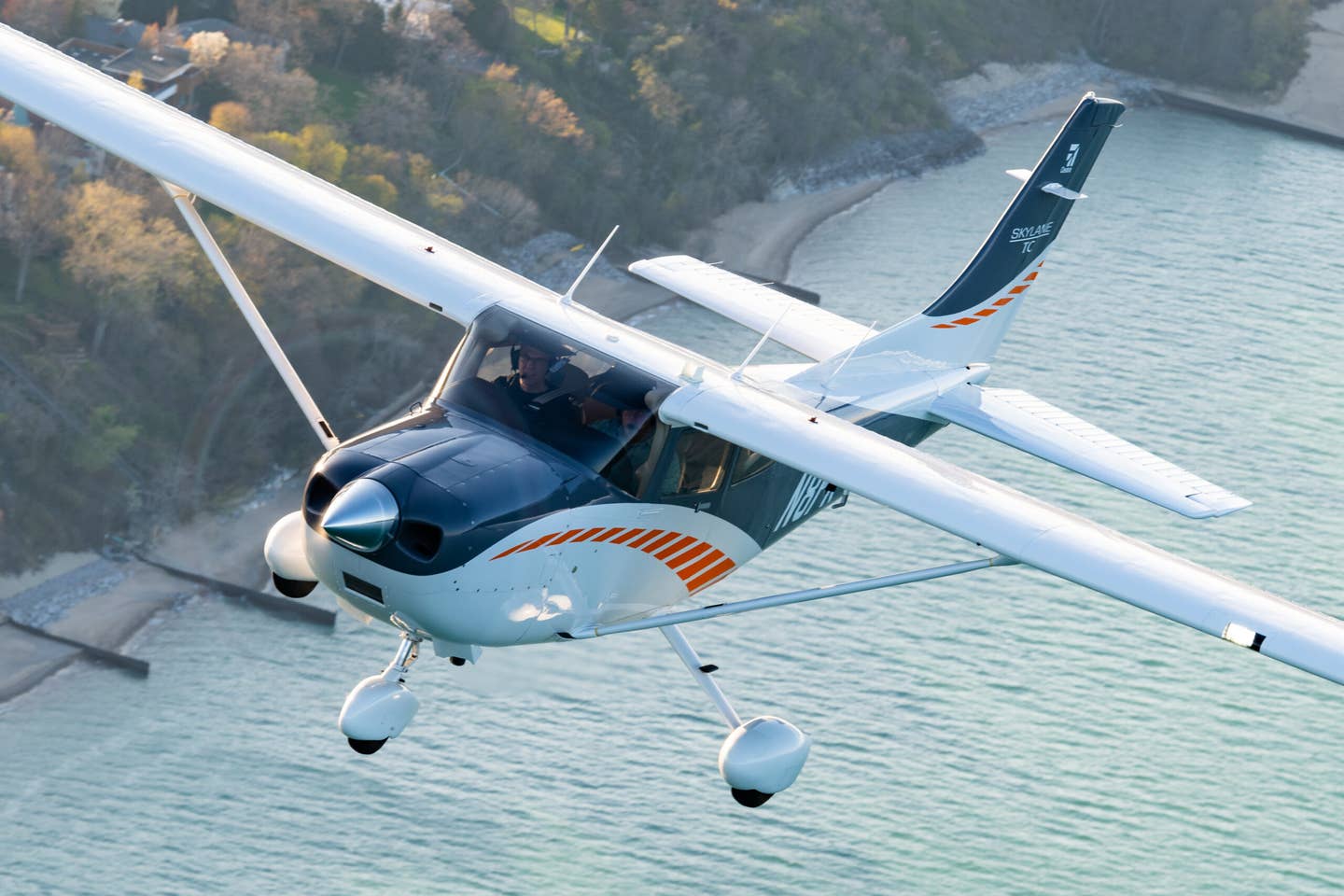
Named the Ultra models, Mooney’s modernized Acclaim and Ovation are now FAA-certified and rolling out of the factory at an increasing rate. As a Mooney pilot and owner, I was excited to evaluate the M20U Ovation Ultra in conjunction with Mooney Aircraft Pilots Association’s annual Homecoming Convention, which was held in late September 2017 at the Inn of the Hills in Kerrville.
My Mooney gal-pal Jolie Lucas and I piled into my 1974 M20C at my home base in Camarillo, California, and headed east along Interstate 10 to meet up with Richard Simile, a Mooney sales representative from Delta Aviation, at his home base in Chandler, Arizona. After a quick lunch, we transferred our luggage from my airplane to the stellar new Ovation Ultra — N197CV.
The Ovation, like many Mooney models before it, has its roots in the M20, a four-seat airplane that was first developed in the early 1950s with wooden empennage and wings. After suffering from wood rot in moist climates, the design was metalized in 1961 with the introduction of the M20B. Though the metal design is a few knots slower, the M20 series has come to be well-regarded for exceptional speed and efficiency. Today, the Ovation’s turbocharged sibling, the M20V Acclaim Ultra, is capable of cruising at 242 ktas in the flight levels.
Of course, it is easiest for me to compare this new airplane to my airplane, which Mooney introduced in 1962. The C model originally had the Johnson bar landing gear retraction system — a simple manual system that many Mooney owners still prefer. But the Johnson bar was replaced with electric gear before my airplane rolled out of the factory, and there has been a continuous evolution through the decades. While the heritage is still evident, there are many letters between C and U, and the changes and upgrades are evident throughout.
Similarities and differences became immediately apparent when we began to transfer our bags. The general shape of the airplane, the straight tail and the landing gear, with gear shock disks on the main and nose gear legs, are basically identical to my airplane. The luggage door is still in the same location and about the same size as mine. It would be nice to have a larger opening to load gear through. But this isn’t possible because of the airplane’s steel safety cage, which is made of high-grade chromoly steel similar to that used to manufacture rifles. Personally, I prefer safety to convenience.
While my M20C has an all-aluminum shell, the Ovation Ultra has a hybrid composite and metal airframe. Both airplanes have four seats, but the Ovation is 3 feet 6 inches longer, providing more rear-seat legroom and space for luggage. The engine cowl and cabin section of the fuselage are composite, and so are the winglets and fairings, allowing for optimized aerodynamic shaping with the light yet strong material. The remainder of the airframe, including the wings, is made of steel and aluminum. Like its predecessors, the Ovation retains pushrods for controls, making the airplane ultra responsive.
There are air vents in the ceiling, just like on the M20C, but the Ovation’s are much more modern and effective. N197CV didn’t have air conditioning, but I didn’t miss it. The temps were typical Arizona hot in Chandler — about 90 degrees — but with both doors cracked there was plenty of air on the ground, and once in the air the seven air vents and two exhaust vents kept us comfortable. Other than the $28,900 additional cost, a good reason not to add the AC option is to retain more useful load.
Another commonality between the Ovation Ultra and my 42-year-old beast is the location of the manual trim wheel between the seats. Of course, the new model has electric trim as well, activated through a switch on the yoke, but having the manual trim capability eliminates any issues associated with runaway trim. Rudder trim is also available with a switch on the panel, a luxury I don’t have in the C model.
Switches are designed to use the pilot’s tactile senses to minimize confusion. The rudder switch is a knob with a vertical handle, and the flap switch, which is located right of the rudder trim, is shaped just like a flap. Most electrical switches are oversize rocker switches, which I really liked. The Garmin G1000 NXi avionics suite can be controlled with an alphanumeric keypad located within easy reach of the right hand, so there is no need to reach up to the MFD to enter a flight plan, change frequencies or make other modifications.
One of the things I dislike most about my airplane is the fuel selector. It is a small lever located under my right foot, making it nearly impossible to reach. Mooney has clearly listened to customer feedback, and now the fuel selector is right behind the center section of the instrument panel, within easy reach from both the pilot and copilot seat. The Ovation’s fuel selector also has a much larger and more ergonomic handle. In addition to digital fuel gauges on the MFD, there are analog gauges on top of each wing.
Loaded with full fuel, N197CV weighs in at 2,907 pounds, leaving only 473 pounds to play with. With Richard, Jolie, me and several bags, we had to leave a few gallons of fuel behind to stay below gross weight. However, with a capacity of 100 gallons of fuel we could have flown for several hours even if we had to drop to half tanks. On our return trip from Kerrville, we simulated a full-fuel scenario, which would have allowed the airplane to fly nonstop all the way to Camarillo at max cruise power, burning about 17 gph. The enormous fuel capacity gives great flexibility if you want to get somewhere without landing. You just can’t do it with a full load of passengers and bags, a common quandary in most light GA airplanes.
The addition of a door on the pilot’s side comes as a welcome change to Mooney enthusiasts. Getting in without having to squeeze through to the left seat from the right side is fantastic. Both doors are a full 4 inches wider than the original single door, making for easy ingress and egress to the front seats. However, the backrests on the pilot and copilot seats don’t fold forward easily or far enough to allow the passengers to gracefully climb into the rear seats.
The seats are handmade by artisans in the Kerrville factory, and the cabin comfort is out of this world. The luxurious leather seats have multiple adjustment capabilities to provide the optimal position in terms of height and reach for the rudders and yoke. Even after our longest leg, which nibbled on four hours, I had no pressure points and no pain while sitting or exiting the airplane. Upon folding myself out of my C model after a long flight I have to perform several stretches to feel remotely normal.
Our ultimate destination was Kerrville, but we decided to have some fun along the way. Richard suggested a stop at the White Sands National Monument in Alamogordo, New Mexico. The area has a rich and varied military and space aviation history, and the Alamogordo-White Sands Regional Airport (KALM) sits under a vast network of restricted areas. The only way to get to Alamogordo as a civilian pilot is through a couple of narrow corridors.
In addition to the diversion for the restricted areas, the afternoon flight through Arizona and New Mexico forced us to fly around some pretty nasty storm cells. Garmin’s G1000 NXi made the diversions a piece of cake. The new system features a markedly improved processor and screen resolution. Like the earlier G1000 versions, the Nexrad weather data on the MFD made it easy to modify the flight plan early in the flight to avoid the worst areas. In addition to the animated radar imagery, we used the SCIT (Storm Cell Identification and Tracking) icons — tiny yellow boxes with arrows indicating the direction of the most intense storm cells and their speed of travel — to guide us to the safest route.
Other handy weather data that helped us avoid the worst of the weather included top-of-cloud information. These weather features are available through a SiriusXM subscription (free for the first year), as is satellite radio, which we also enjoyed along the way. Two Bose A20 headsets are included with the purchase of an Ovation Ultra, and they provide terrific sound quality and noise cancellation.
Another beautiful new feature incorporated in the NXi system is the ability to display the flight plan and moving map right on the HSI on the PFD. This feature made the transition through the narrow corridor in Alamogordo a whole lot easier to navigate. The corridor is only about 2 miles wide, so my focus was to keep the wingtips of the imaginary airplane on the screen from touching the blue lines that outlined the restricted areas.
After three hours flying from Camarillo to Chandler, another two-plus hours to Alamogordo, and losing one hour due to the time change between California and New Mexico, we arrived at KALM only about one hour before sunset. The local FBO, Exile Aviation, was closed already, but Richard had called ahead and the owner had been kind enough to leave his truck for us to use. There was barely enough time to take a drive out to the stunning white-sand dunes west of town. The serenity and beauty of the area took my breath away, and the experience highlighted the ability of a fast airplane to take you to a completely different environment in a very short amount of time.
The following day presented perfect conditions for showing off the terrific capabilities of the Ovation Ultra. There were multiple cloud layers between New Mexico and Texas, so in addition to diverting back through the restricted airspace corridor, we modified our direct flight plan around the heaviest areas of precipitation in Texas.
After flying under VFR through the corridor, we stayed low under broken to overcast skies until our IFR clearance was issued. I was hand-flying the airplane and expected to push the little AP switch on the terrific GFC 700 autopilot panel to reduce my workload as soon as I climbed into the clouds. However, the airplane felt so comfortable and stable that I pressed on without the help of the autopilot.
With the pink boxes on the Garmin PFD to help keep me on the perfect path vertically and horizontally at all times, hand-flying accurately in IMC was easy. I never activated the autopilot during the entire 3½-hour flight from Alamogordo to Kerrville. I even managed to make myself a snack, with crackers, meat and cheese that Jolie had brought, while controlling the airplane. The experience really showed the stability of the Ovation’s extended fuselage. There is no way I would attempt a 3½-hour flight in mostly IMC in my airplane.
With temperatures above 50 degrees during our flight at 9,000 feet, there was no concern for the wings to ice up. However, the TKS weeping-wing option, which adds $64,990 to the final price tag, is well worth it if you plan to take your Ovation into the clouds. The system keeps the windshield, elevator, propeller, and leading edges of the wings and horizontal and vertical stabilizers clear of ice. Both the Ovation and Acclaim Ultra are flight-into-known-icing certified.
The arrival into Kerrville Municipal Airport (KERV) provided the ultimate demonstration of the Ovation’s capabilities. The clouds were thick over most of Texas, with layers that extended from just a few hundred feet agl to above 20,000 feet msl. With the MAPA convention beginning that day, there was another airplane coming in, and ATC issued us a hold at OBUCO — the initial approach fix for the RNAV Runway 12 approach into Kerrville. Using a tiny button on the left side of the yoke, I popped the speedbrakes to help slow the airplane down.
The NXi produced the procedure turn at OBUCO right on the MFD and on the miniature HSI that I had already fallen in love with. If you’ve never flown a hold on a glass panel, you have to give it a try. There is no guesswork and no calculations required. For someone who learned to fly on instruments with round gauges, it feels like cheating.
Flying an approach is just as easy, and there are multiple ways to ensure you are on track, such as the magenta highway-in-the-sky boxes, the glidepath icon next to the altimeter, a horizontal track indicator below the attitude indicator and the moving map inside the HSI — all on the PFD in front of the pilot’s face.
The MFD displays all the legs of the approach along with own-ship position on top of a moving map. I split that screen with the flight-plan page, which provides the step-down altitudes for each fix so that I could verify them even though I was tracking the glidepath indicator on the PFD.
The RNAV Runway 12 is an LPV approach, which provides precise horizontal and vertical guidance down to an altitude of 250 feet above the ground, which was a good thing since the clouds formed a lid at about 600 feet. With the synthetic vision on the PFD, I saw the airport and surrounding terrain while still in the soup. The first thing I saw when we popped out of the clouds was the Mooney factory. With gear down and full flaps, I gradually added trim all the way to the nose-up stop and guided the Ovation to a sweet landing. We were home.
The Ovation Ultra has a 310 hp Continental IO-550-G engine. However, the engine I flew to Kerrville had 280 horses. While at the factory, the engine was converted, so there’s no need to talk about the speed on the way to Kerrville, which was still impressive to me.
While the engine conversion was happening, we checked out the MAPA convention and enjoyed a special event honoring Mike Miles, who retired after more than 41 years at Mooney primarily as a test pilot. Mike conducted more than 1,300 first test flights and is one of many employees who have a Mooney tenure that spans decades.
We also had a chance to tour the factory with Mooney’s vice president of production operations, Robert Dutton. It had been nearly two years since I last toured the factory, and the recent upgrades were impressive. The older equipment had been painted, and there were many new machines on the factory floors, which extend over several hangars — one of which brought forth my airplane in 1974. Though that Quonset hut has been covered, the original structure is still there. There are traces of Mooney’s vast history, including a continuous wing-shaped line where drippings from the glue that fused wood pieces in the original wing structures cut through the concrete.
Major investments have been made in the factory since the Chinese Meijing Group purchased Mooney in 2013, including $500,000 just in lighting upgrades. Hundreds of thousands have been invested in CNC machines to ensure accuracy and predictability in the parts. This, along with the fresh paint and new roofs, hides the fact that this is a production facility that has been in existence for more than six decades.
With a focus on quality and safety, the factory is gearing up for a production rate of one airplane every two weeks. The airplanes are moved through eight assembly-line positions. Most parts and production is done in-house. Currently, work for the Ultra models’ exterior paint and composite fuselage shell is outsourced. Robert said the company plans to bring this work in-house with investments and upgrades to the existing carbon and glass composite capabilities.
Unfortunately, all good things must come to an end, and the three of us once again strapped ourselves into the airbag seat belts in the Ovation, this time behind 30 additional horses. Despite our heavy load, we were off the ground before the 1,000-foot markers on Runway 12. The runway has a 687-foot-long displaced threshold, so the ground roll was no more than about 1,500 feet.
With fewer airspace and weather issues to worry about as we headed west, we only made a couple of slight diversions around heavier bands of precipitation. At a power setting of 22.6 mp and 2,600 rpm, our TAS was about 190 knots at 8,000 feet, burning 17 gph. We remained at 8,000 feet during most of the flight to avoid hypoxia — the Ovation does not have a built-in oxygen system. But without the ability to climb to thinner air, as the turbocharged Acclaim can, the Ovation tops out at 197 ktas. Our flight time from KERV to KCHD was about three hours and 45 minutes for the approximately 700 nm leg. By comparison, the flight Jolie and I flew from KCHD to KCMA, a distance of 370 nm, was nearly three hours — about three-quarters of the time to travel a little more than half the distance. However, we had a slight headwind on our way to Camarillo, whereas the winds were in our favor from Texas to Arizona.
While the weather was the typical Arizona severe clear, we decided to try another approach, this time with the autopilot. Coming in from the east, there was no logical approach into Chandler. Richard suggested an approach into Phoenix-Mesa Gateway Airport (KIWA). I loaded the RNAV Y Runway 30C into the G1000 NXi and, while managing power and rudder trim, I let the autopilot fly the entire approach, terminating above the decision altitude by adding power and pushing the go-around button above the throttle, which puts the flight director in a 6-degree climb attitude and sequences the avionics to the missed approach. We didn’t fly the missed approach procedure, but instead turned the Ovation straight toward Runway 22R at Chandler.
While I love my airplane, it was a tad depressing going from the brand-new Ovation back to what is essentially its grandfather. The speed, the comfort, the avionics and the ease of flying add up to an exceptional package. No matter how much time I spent in the left seat of the Ovation, I felt I could have spent more. At a base price of $689,000, the Ovation Ultra is nearly 10 times the value of my Mooney. Is it 10 times better? Unquestionably, yes!

Sign-up for newsletters & special offers!
Get the latest FLYING stories & special offers delivered directly to your inbox








